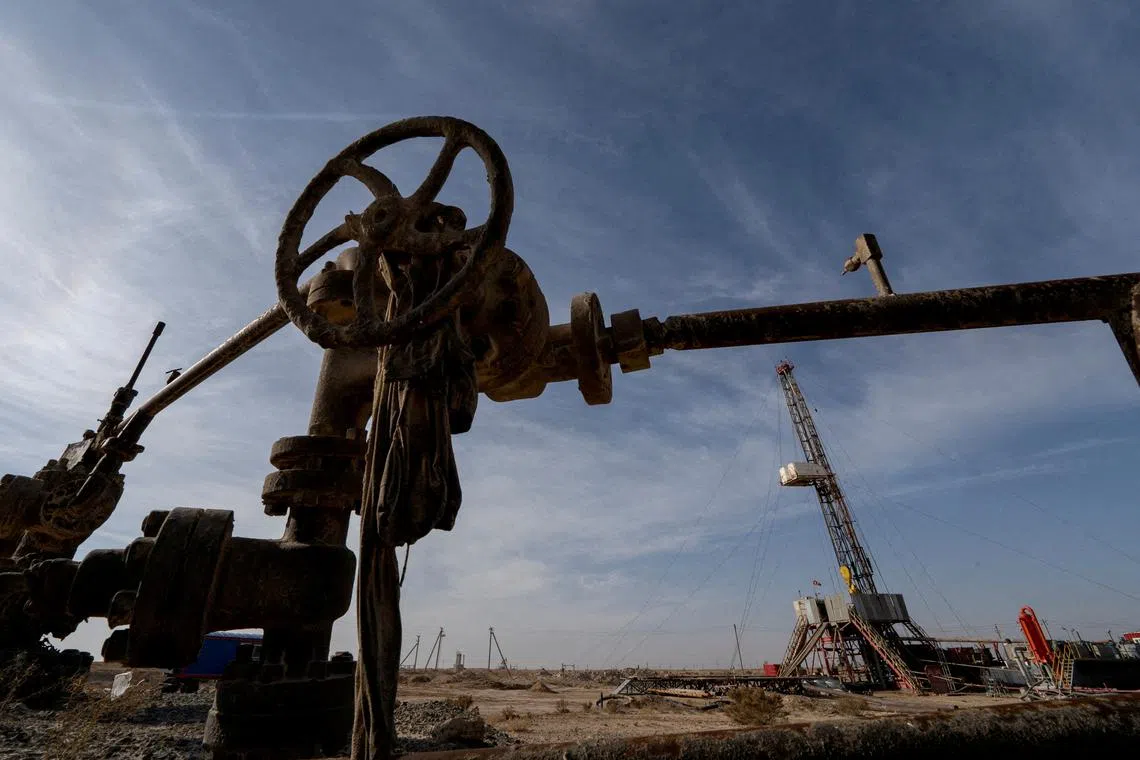SGX-listed energy stocks surge, regional names mixed as oil prices rally on Israel-Iran conflict
Sign up now: Get ST's newsletters delivered to your inbox

Oil prices had jumped 7 per cent on June 13 as Israel and Iran first traded strikes.
PHOTO: REUTERS
Follow topic:
SINGAPORE – Several energy counters in Asia jumped in early trade on June 16, on the back of global crude oil prices surging amid escalating conflict in the Middle East between Iran and Israel.
Brent crude futures rose US$1.70 or 2.3 per cent to US$75.93 a barrel during Asia hours, while US West Texas Intermediate crude futures gained US$1.62, or 2.2 per cent, to US$74.60.
Oil prices jumped 7 per cent on June 13 as Israel and Iran first traded strikes.
In Singapore, shares of oil and gas companies listed on the Singapore Exchange (SGX) such as Rex International and RH PetroGas rose more than 6 per cent at market open on June 16.
As at 9.04am, multinational oil exploration and production company Rex International gained 9.8 per cent, or two cents, to 22.5 cents, with 13.3 million securities changing hands. Its share price closed lower at 22 cents, though the counter was still up 7.3 per cent, or 1.5 cents.
The company’s share price has had an upward trajectory since early June, following its June 6 update on its subsidiary Lime Petroleum Holding’s assets in Norway, Benin and Germany.
Notably, Lime Resources Germany, which was founded in late 2024, was said to have interests in four onshore exploration licences and one onshore production licence in the Rhine Valley, and one onshore production licence in Bavaria.
Its share price has since increased steadily from 14 cents on June 9, to 18 cents on June 11 and 20.5 cents on June 13.
On Nov 7, 2023, Lime Petroleum entered an agreement to acquire a 17 per cent interest in PL740, an oil and gas licence for a field in the Norwegian North Sea.
In addition, RH PetroGas was up 6.8 per cent, or 1.3 cents, at 20.5 cents, with 5.2 million securities changing hands. Its share price closed at 19.8 cents, or up 3.1 per cent.
The company also had regular improvement in its price performance before the spike on June 16 from its June 10 price of 14.1 cents.
Other maritime and energy SGX-listed stocks had sharp increases of more than 10 per cent, and recording around 21 per cent were Mermaid Maritime and CH Offshore, to 12.1 cents and 1.7 cents, respectively.
At market close, their share prices eased to 11.7 cents and 1.5 cents, respectively.
Meanwhile, oil and gas counters in Malaysia such as Petronas Gas and Dialog Group were up 0.7 per cent at RM17.96, and 3.8 per cent at RM1.63 in early trade, respectively.
Equity research analyst at Maybank Jeremie Yap has kept a “buy” rating on Dialog Group and an unchanged target price of RM2.34, considering how the group has signed a production sharing contract with Petronas for the Mutiara Cluster small field asset, located off the coast of Sabah.
“We understand that ChemOne’s development of Pengerang Energy Complex and Petronas’ RM6 billion (S$1.8 billion) development of a biorefinery with Eni and Euglena could require tank terminals for storage of refined and/or crude products, which Dialog Group is well-positioned to secure,” he said in his June 15 report.
The FBM KLCI Energy Index rose 11 points, or 1.5 per cent, to 751.86.
On the Hong Kong stock exchange, China National Offshore Oil Corp was down nearly 1 per cent, or 14 Hong Kong cents, at HK$18.56 as at 11.59am.
PetroChina shares were also down 0.5 per cent, or four Hong Kong cents, at HK$7.36.
Official data released on June 16 showed that China’s crude oil output declined by 1.8 per cent in May from a year earlier to the lowest level since August 2024, as maintenance at both state-owned and independent refineries curbed operations.
Will crude oil prices jump further?
UOB head of markets strategy Heng Koon How said that past conflicts between Israel and Iran over the last year had limited impact on oil prices, on a medium-term horizon.
A key reason for this is that the US is now a major producer of crude oil. “The US now produces more than 13 million bpd (barrels per day), significantly more than the current nine million bpd production from Saudi Arabia,” wrote Mr Heng on June 16.
DBS chief economist Taimur Baig and foreign exchange and credit strategist Chang Wei Liang echoed Mr Heng’s sentiment, noting that the market thus far is “inclined to coalesce around the less-dire possibilities”.
“The fact that the Iraq-Iran war during the 1980s and associated disruptions to oil and gas supply and production did not cause a 1970s-style oil shock may well be informing the market’s composure,” they wrote in their report on June 16.
“At a time when global demand softness is a greater source of worry than supply tightness, the bar for a major oil rally is high.”
That said, a dangerous escalation would be for Iran to target US military assets or attack regional crude oil production, storage and shipping facilities across the Middle East, said UOB’s Mr Heng.
He added: “The worst-case scenario would be a blockade of the Strait of Hormuz – a key shipping lane – which would disrupt crude oil supply to the rest of the world suddenly.”
Although near-term volatility is considered, Mr Heng refrains from making any “knee-jerk adjustments” to his Brent oil forecast of US$65 per barrel for the third quarter of 2025, and US$60 per barrel for the fourth quarter of the year.
“This is ultimately pending further developments in the two key variables – that of Iran’s extent of retaliation and the reaction function of Saudi Arabia and Opec+ (the Organisation of the Petroleum Exporting Countries and other oil-producing nations),” he noted. THE BUSINESS TIMES

